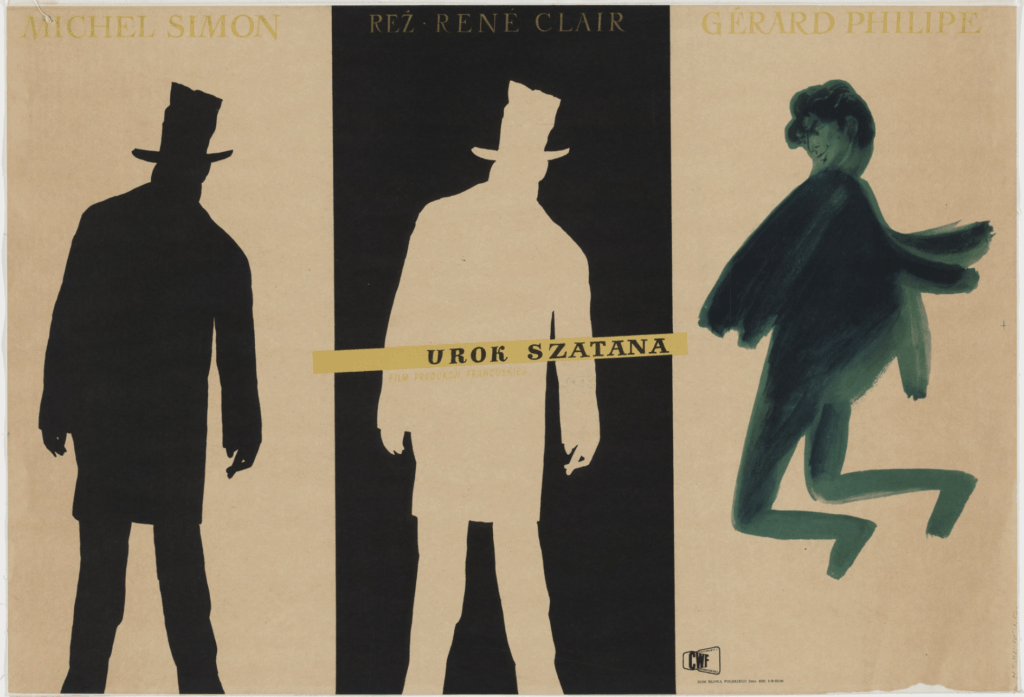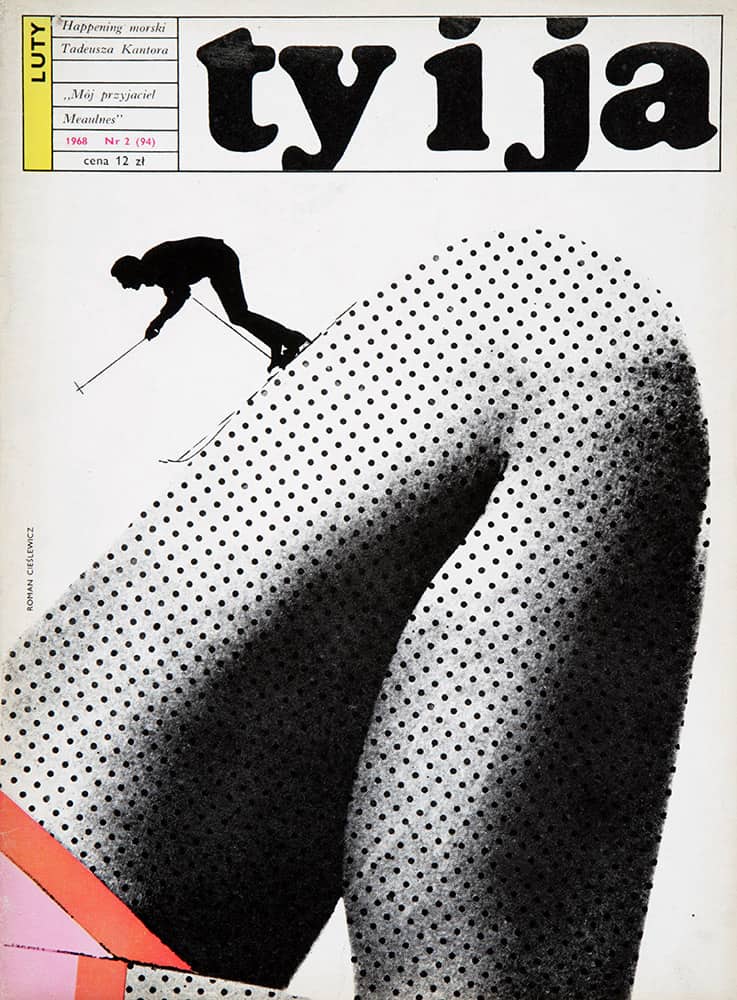Articles and Features
The Polish School of Posters and the Pursuit of Creative Freedom
By Shira Wolfe
“All (Polish) posters should be designed by individual artists who should have freedom of interpretation and artistic expression.”
– Ministry for Culture and the Arts, The Polish People’s Republic
The History of the Polish School of Posters
The Polish School of Posters originated at a unique moment in history when posters were the only medium in which artists were allowed relative artistic freedom by the Communist state. The Second World War had just ended and the Polish People’s Republic suffered intense repression under Soviet rule. In most fields related to the arts, artists were forced to conform to a strict Communist art style. The pioneers of the Polish School of Posters, however, struck a deal in which they agreed on the fact that the posters would not have to adhere to the Social Realist style. The artists were instructed to reject Western values in their posters and were to follow rules about appropriate messaging, but other than that, they had complete artistic freedom. This resulted in bold, unique visual impressions which still managed to introduce subversive thinking in subtle ways. For the state, posters were a cheap means of propaganda, with which they intended to promote the work of the Ministry of Art and Culture. People had been starved of culture and flooded to the cinema and the theatre. For the artists, posters became their way to experiment with avant-garde ideas and approaches and to freely experiment with form, liberated from commercial considerations. Most of the posters were executed in a painterly fashion, with handcrafted typography and rich metaphors and symbolism. The artists wished to convey their actual experiences and feelings connected to the movies and plays they made the posters for, a unique approach at the time. The peak of the Polish School of Posters came during the 1950s, 1960s and 1970s. We highlight several of the most influential, pioneering artists who contributed to its iconic visual language.
“We all agreed that [the head of the State Film Agency] should not expect us to design anything that resembled Japanese, American, Russian, or Swiss posters. I was trying to find the essence of the film. I was trying to feel the impression that the film had on me, whether it was a lyrical film, comedy, drama, sport or war film. I wanted to illustrate this essence with my own language, in my own way.”
Henryk Tomaszewski

Henryk Tomaszewski
Henryk Tomaszewski is known as one of the fathers of the Polish School of Posters and was a poster and graphic artist and a professor at the Warsaw Academy of Fine Arts Poster Studio. His posters were intelligent and provocative, with compositions stripped down to the essentials that always carried a distinct message through a symbolic visual expression. Tomaszewski was committed to searching for signs and symbols that would be comprehensible for everyone, and was searching for the very essence of the film: “We all agreed that [the head of the State Film Agency] should not expect us to design anything that resembled Japanese, American, Russian, or Swiss posters. I was trying to find the essence of the film. I was trying to feel the impression that the film had on me, whether it was a lyrical film, comedy, drama, sport or war film. I wanted to illustrate this essence with my own language, in my own way.” His iconic poster designs include theatre posters for Oedipus the King and Hamlet, and his film poster for Citizen Kane.
Jan Lenica
Jan Lenica is believed to be the artist who coined the term “Polish School of Posters”. He was considered one of the finest poster artists of his time and also earned international acclaim for his animated films. Lenica made over 200 posters throughout his career, and famous ones include his poster for Alban Berg’s opera Wozzeck (1964), for which he won the Grand Prix at the Poster Biennial in Warsaw in 1966, and his poster for the 1968 production of Verdi’s Otello. In 1954 he was appointed assistant to Henryk Tomaszewski at the Warsaw Academy of Fine Arts. For Lenica, poster art was closest to jazz, as he explained: “It is all about being able to play somebody else’s theme in one’s own way.” Lenica distinguished three stages in the development of his artistic poster language. The first, between 1950-56, was influenced by realism, when he attempted to convey the climate of the films or plays. Then, he started the period of formal search, when he began introducing experimental means of expression like collages of old drawings. Around 1962, when he started making posters for the Warsaw Opera, he embarked on the third stage of his poster design. During this period he developed his own handwriting which he used for the text on the posters, and began working with more flowing, wavy lines.

Roman Cieślewicz
Roman Cieślewicz was one of the founders of the Polish School of Posters. He believed in the power of posters to reach a wide public with his art, saying: “It was my dream to make public pictures that could be seen by as many people as possible. Hence the utmost importance of the poster – the street picture.” He worked for various Polish magazines and organisations, creating works for the Film Distribution Office, the WAG state graphic agency, the Polish Chamber of Foreign Trade, the art magazine Project, and the monthlies Ty i Ja and Polska. He emigrated to Paris in 1963, where he designed the layout for magazines such as Elle, Vogue and Opus International, and also designed the catalogues for exhibitions at Centre Pompidou. Especially in his later period, Cieślewicz was inspired by Russian Constructivism of the 1920s and the Polish art collective Blok.
Wiktor Górka
Wiktor Górka was another one of the founders of the Polish School of Posters. He worked for some of the largest Polish publishers and film distributors between the 1950s and 1980s, designing nearly 300 posters, as well as book and magazine covers and commercial logos and prints. Górka’s posters for films include: Spartacus, Beatrice Cenci, The Great Escape, 2001: A Space Odyssey, Sleepy Hollow, Marathon Man and Cabaret. The poster for Cabaret is perhaps his most famous work, depicting a cabaret dancer’s legs in black stockings and the face of Joel Grey in dramatic makeup, together forming the shape of a swastika. Górka went to Havana, Cuba in 1970 to conduct design workshops, and later ended up in Mexico where he worked as an artist and teacher. He received the biggest award for his contribution to the development of graphic arts in Mexico in 2000 at the 6th International Poster Biennial.

Jan Mlodożeniec
Jan Mlodożeniec worked as a graphic designer for film distributors, theatres, publishing houses and magazines. His posters for films like The Serpent’s Egg, Klute, Once Upon a Time in America, The Godfather, The Great Gatsby and The Conformist became iconic in the world of cinema and were characterised by his unique style. Mlodożeniec used thick lines and a childlike forms with vivid colours and humour. He painted letters by hand in order to create a better interplay with his art and was deeply inspired by the national folk culture. At the same time his visual language was totally modern, inspired by artists such as Fernand Léger, Pablo Picasso, Georges Braque, Henri Matisse and Paul Klee.
Relevant sources to learn more
Learn more about the Polish School of Posters in The Guardian
This article in Culture.pl gives an overview of other important Polish graphic designers
Read about Henryk Tomaszewski, one of the founders of the Polish School of Posters, here
Discover more famous art movements and styles here


